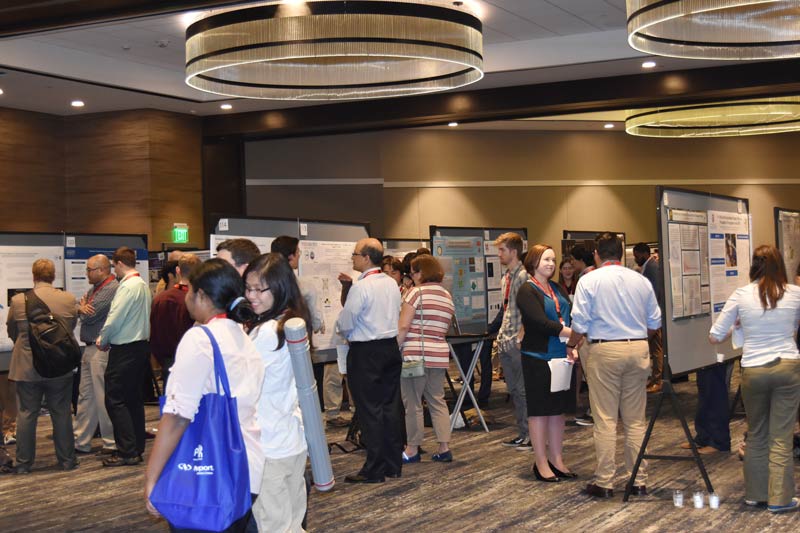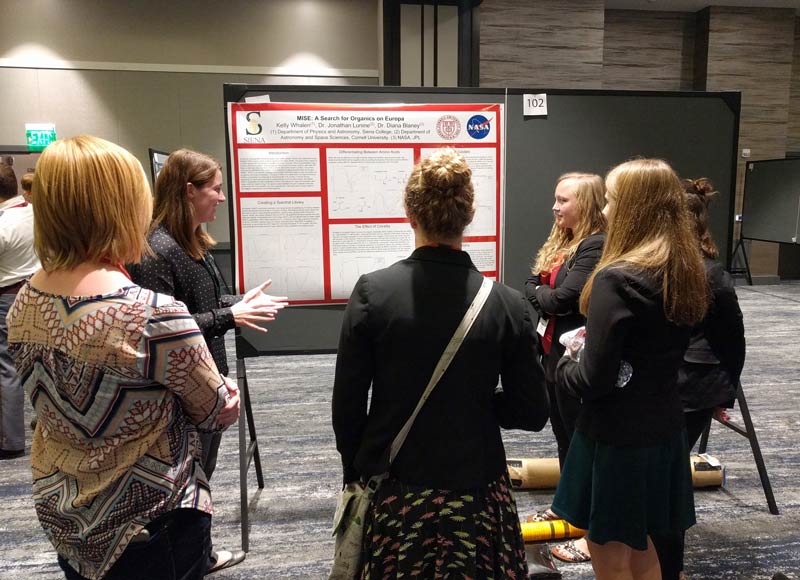Second Poster and Art Session
Sigma Pi Sigma Physics Congress (PhysCon)
November 3, 2016 to November 5, 2016
San Francisco, CA
Meeting host: By:Nathaniel Moore, Zane Thornburg, Justine Walker
SPS Chapter:

What happens when you let a “CoW” into PhysCon’s poster session? Four of us, representing the College of Wooster in Wooster, Ohio, were about to find out. We were given the opportunity to talk with many of the young scientists at one of the two poster sessions. We wanted to represent our college in the best way that we could--by talking with as many people as possible.
When we entered the second poster session of PhysCon 2016, we found it was teeming with many young scientists explaining their recent research, and many people from the Congress looking at the research. Some of the young scientists talked about physics research they had performed recently while others talked about their outreach projects and studies done on the pursuit of physics. Many expressed their happiness about being at PhysCon and participating in the poster session.
We got an opportunity to ask these young scientists what they were thinking during this time.
Brean Prefontaine, a student at Drexel University, when asked about how she felt the poster session was going, explained that she thought it was going well, and that lots of people were coming to talk to her about her research opportunity for high school students to learn particle physics. She remarked further that there were a lot of good questions being asked.
We also asked the presenters how they felt about their own interests in what they want to do with their physics degrees. Many of the presenters responded that they were very uncertain, but that their research experiences had helped them clarify their thoughts.
The presenters we talked to were happy that they were able to get their feet wet with research because it helped them to know what kind of work they want to do later on in life, even if they do not know the exact area of study yet. Others said that doing research and giving presentations helped them understand that they wanted to stay in physics.

Some of the presenters were just pleased to have a chance to present their research. They had gone to other conferences with their research, and going to this Congress was a good way to continue presenting. One attending member mentioned that they felt that doing this was important for exposing the common interests in physics majors and also was an excellent way to network.
Another poster presenter, Sebastian Hendrickx-Rodriguez of New Mexico Tech, said that he "was also very glad that I could present my research to so many fellow students and scientists." He also remarked that he thought that being part of a poster session is an important part of the undergraduate process. He explained that this experience gives people hoping to study science an opportunity to see how to properly communicate their scientific work, a skill that he thinks will be "extremely crucial" in the future.
Most of these young scientists had actively involved advisors, but still did the bulk of the work on their projects themselves. There were long days of frustration as they worked diligently on their problems. But most students agreed it felt amazing to finally get to the finish line.
As we continued to walk through the rows of posters and people presenting their work one thought came to mind: How were these students deciding what to research? We were surprised to get a mix of responses. Hendrickx-Rodriguez spoke of how his own research came from his personal curiosity. He was fascinated by asteroids and how to 3-D model them so he took initiative and began his research, eventually becoming funded through multiple grants.
Another student, Lauren Keyes, approached a professor with the interest of doing research in that professor’s field. Unfortunately, the professor said that Keyes had not taken the classes necessary to do research in that field yet. However, because of Keyes’s enthusiasm, the professor offered another project, looking into statistics on undergraduate women in physics and how to improve retention.
One of the things we learned from the variety of answers to this question is that it’s important to always ask about possible research opportunities. You never know where asking may lead.
We already thought the poster session was impressive, but after speaking with a few people who have attended more than one PhysCon we realized we were not alone in our excitement. According to one attendee who was also at the last PhysCon, the posters were “off the scale” in terms of the number of posters this year.
Having such a large quantity of posters made it difficult to determine which ones to go and see, but also the large quantity made it so that anyone was sure to find one of interest that would not be too crowded.
It wasn’t just quantity, but quality too. Another second-time attendee said, “I am significantly impressed in the quality of the projects, presentations, and posters.”
To us first-timers, the poster session felt very professional and speaking with various presenters about their work was engaging. To the attendees who had been here before, the session was one of the higher quality PhysCon poster sessions they had attended.
The poster session was diverse both in terms of who the presenters were and the work being presented. This gives us hope that in the future that physics is a field which will continue to strive to increase its diversity. We were excited to see so many fellow undergraduate physicists professionally presenting their research, and we look forward to reading about the next PhysCon poster sessions.